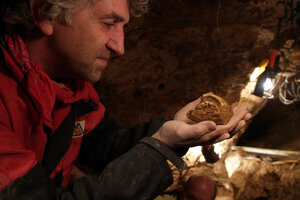Was Neanderthal's evolution a 'Game of Thrones scenario'?
Scientists reveal 17 skulls belonging to ancestors of Neanderthals. These bones tell a tale of evolution in stages and in different regions – not all at once.

Professor Juan Luis Arsuaga examines an artefact at the Sima de los Huesos site in Sierra de Atapuerca, Spain. Scientists unearthed 17 fossil skulls in the cave dating from about 430,000 years ago of an extinct human species closely related to the Neanderthals.
Madrid Scientific Films/Javier Trueba
Some 430,000 years ago, a band of humans with large jaws and small crania lived in what is now northern Spain.
Seventeen of their skulls, recently unearthed from a cave in the Atapuerca Mountains known as the Sima de los Huesos – the Pit of Bones – clarify complicated questions about the evolution of ancient humans.
An analysis of the skulls published this week in the journal Science suggests that our ancient cousins, the Neanderthals, evolved their characteristic facial features before their large brains. These skulls display the prominent nose and mouth of their Neanderthal descendants, who lived in Europe until about 30,000 years ago, but the brain cases match those of more primitive humans.
This pattern of evolution in stages agrees with the so-called accretion model, which states that hominids evolved in isolated groups. Study author Juan-Luis Arsuaga of the Universidad Complutense de Madrid describes it as a "Game of Thrones scenario."
In this scenario, the Neanderthals did not develop all of their identifying features as a package along the same, continuous timeline. Instead, different groups of these hominids adapted their traits at different points.
But how does George R.R. Martin's fantasy series fit in? "As in the famous saga, there was never a unified and uniform European middle pleistocene kingdom," explains Dr. Arsuaga at a news conference. These small, isolated populations could have evolved distinct traits relatively quickly within their limited gene pools.
Also, if these humans were truly like their fictional counterparts, they would have disputes as they competed for survival. But "there periodically spread a thick crust of ice over a great part of the disputed land," says Arsuaga.
As the glaciers descended over Europe, these ancient humans could move south with the changing habitat, or risk extinction in the oncoming ice age.
"In those times, as in the popular saga, winter was coming," says Arsuaga. "And winter came many times."
The skulls were discovered in southern Europe, so these people likely weren't struggling through glacial challenges. They do shed new light on the nature of Neanderthal evolution as "the earliest safe or definite Neanderthal traits," says Arsuaga.
Chewing before thinking
The evolution of pronounced Neanderthal facial features wasn't a fluke. As most of these features emphasize a pronounced chewing mechanism, researchers believe they were an adaptive trait.
Arsuaga explains that these humans likely used their front teeth as a sort of "third hand," grabbing and pulling at large chunks of meat. Over generations, the people who could do this most effectively would survive to reproduce more often.
These people also were able to open their mouths much wider. The condyle, the point on the bottom jaw at the joint with the top, is quite a bit lower than that of earlier humans. "We think this really is the most important characteristic," says researcher Rolf Quam of Binghamton University.
But their big mouths weren't matched by big brains. "The brain case shows a more primitive morphology," says study researcher Ignacio Martínez of the Universidad de Alcalá.
Later Neanderthals have larger skulls that protrude at the rear in a feature called an occipital bun. Indeed, previous studies have shown that adult Neanderthals had a cranial capacity even larger than that of modern-day humans. The humans discovered in Spain, by contrast, seemed to have had much smaller brains.
Where do we fit in?
Although Neanderthal evolution doesn't tell us anything anything about our species directly, "there is something by comparison," says Arsuaga.
"Neanderthals have been proven to have very deep roots in the European middle pleistocene, but Homo sapiens lack those deep roots. Maybe this is a question of a lack of a good fossil record."
"We do have a fossil record in Africa as well," where Homo sapiens are thought to have originated, adds Dr. Quam. But "It's not as rich as the fossil record in Europe at the same time period."
The earliest fossils that can be considered "pre-sapiens" have been dated from about 200,000 years ago, says Arsuaga. Meanwhile, this study shows Neanderthal evolution had already begun at least 430,000 years ago.
Researchers will continue to pursue answers at Sima de los Huesos, as the skulls presented in this paper are still missing some pieces.
Anthropology has several distinct taxonomic names – including Homo erectus, Homo heidelbergensis, and Homo neanderthalensis – denoting what are believed to be the various species of ancient humans, but Arsuaga was hesitant to categorize these skulls among the existing terms. Instead, he plans to discuss and reevaluate the way humans are divided and designated.
"This is one of the big questions," says Quam. "What is it that makes us human?"

